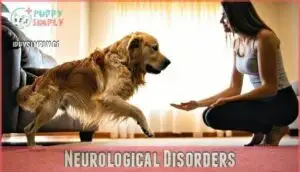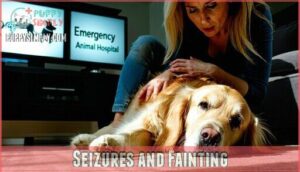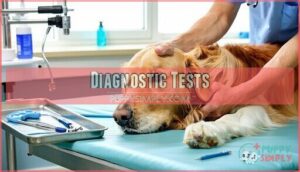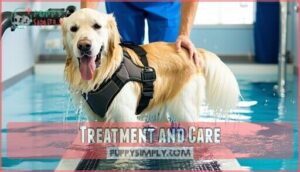This site is supported by our readers. We may earn a commission, at no cost to you, if you purchase through links.

Watch for other symptoms like head tilting, vomiting, or unusual eye movements (nystagmus). Causes range from inner ear infections to low blood sugar or even accidental toxin ingestion—think chocolate, medications, or household cleaners.
Don’t wait this one out; get your pup to the vet ASAP. Quick action can make all the difference. In the meantime, keep them calm and safe from falls.
Curious about what treatments or preventive steps might help? There’s more to unpack on this topic, including considerations for accidental toxin ingestion and the importance of getting your pup to the vet.
Table Of Contents
- Key Takeaways
- Dog Acting Drunk
- Causes of Wobbliness
- Symptoms and Diagnosis
- Treatment and Care
- Emergency Actions
- Frequently Asked Questions (FAQs)
- Why is my dog wobbling like he’s drunk?
- What to do if your dog is wobbly and off balance all of a sudden?
- What are the signs and symptoms of a stroke in a dog?
- How do you treat a dog that is disoriented and stumbling?
- What causes a dog to be wobbly and off balance?
- Why is my dog walking wobbly and acting like it’s drunk?
- What should I do if my dog is drunk or wobbly?
- What does it mean if a dog is drunk and wobbly?
- Why is my dog acting weird & wobbly?
- Why is my dog acting drunk?
- Conclusion
Key Takeaways
- Keep your dog safe and calm if they’re acting drunk and wobbly—call your vet right away to diagnose the cause.
- Common culprits include inner ear infections, vestibular disease, low blood sugar, or accidental poisoning.
- Watch for other symptoms like head tilting, vomiting, or unusual eye movements, as these can point to serious issues.
- Quick action and veterinary care are essential—don’t wait it out or try to self-diagnose.
Dog Acting Drunk
When your dog suddenly looks wobbly or seems to stumble around like they’ve had one too many, it can be both confusing and alarming.
A wobbly, stumbling dog can feel like a mystery—don’t ignore the signs; their balance system needs attention.
This unsteady behavior often points to issues with their balance system, requiring a closer look at the possible causes.
Nystagmus and Strabismus
If your dog’s eyes are darting uncontrollably, they may have nystagmus, a condition tied to dog neurological issues and balance problems.
Nystagmus, with its rapid eye movements, often signals underlying neurological issues, making your dog appear wobbly and disoriented.
This eye movement disorder often pairs with dog ataxia, making your pup appear “drunk.” Another related issue is strabismus, where the eyes misalign, causing vision impairment.
Here’s what to know about these conditions:
- Nystagmus causes rapid, jerky eye movements, often horizontal or vertical.
- Strabismus types include crossed or outward-turned eyes.
- Both link to dog balance issues and neurological dysfunction.
- Symptoms often include head tilting or circling.
- Eye movement direction helps pinpoint the underlying problem.
Consult your vet promptly!
Prognosis for Vestibular Disease
The prognosis for vestibular disease in dogs is usually encouraging. Most pups show noticeable improvement within 72 hours, with a full recovery timeline of 2-3 weeks.
While some may have residual effects like a quirky head tilt, their quality of life typically bounces back to normal. For idiopathic cases, the recurrence risk is low.
Changes in behavior should be closely monitored. With supportive care and regular check-ups, your wobbly companion can overcome canine incoordination, reclaiming their balance and happy tail wags.
Causes of Wobbliness
Your dog’s wobbly, drunken movements might stem from several underlying causes. These can include ear infections, low blood sugar, neurological issues, or even accidental poisoning.
Intoxication
A wobbly, "drunk" gait might mean your dog has encountered toxic substances. Intoxication can happen if they ingest household chemicals, antifreeze, or slug pellets. Even mold exposure or accidental medication overdoses can trigger alarming symptoms.
- Neurological signs like disorientation or unsteady walking.
- Gastrointestinal distress, including vomiting or drooling.
- Behavioral changes, such as excessive vocalizing or lethargy.
Quick action is vital—contact your vet immediately to address the toxicity and prevent complications.
Ear Infections
Inner and middle ear infections can make your pup wobble like they’ve had one too many treats.
Common signs include head shaking, ear scratching, or smelly discharge.
Chronic infections might need surgical options if antibiotics fail, but overuse risks antibiotic resistance.
Preventative care, like regular ear cleaning, helps avoid trouble.
| Ear Infection Types | Symptoms | Treatment | Prevention |
|---|---|---|---|
| Inner ear infections | Balance issues | Antibiotics, surgery | Routine vet checks |
| Middle ear infections | Head tilting | Medications, cleaning | Proper ear hygiene |
| Chronic infections | Persistent symptoms | Advanced procedures | Early intervention |
| Dog ear infections | Discharge, odor | Vet-prescribed remedies | Regular monitoring |
Always consult your vet for safe, effective care!
Hypoglycemia
Low blood sugar, or hypoglycemia, can leave your furry friend shaky and confused.
Watch for signs like dog weakness, tremors, or fainting. Common causes include insulin overdose, poor dietary management, or toxins like xylitol.
Quick action is key:
- Symptoms: Seizures, dog disorientation, gait abnormalities.
- Treatment: Sugar boost or IV dextrose.
- Prevention: Balanced meals, monitoring diabetic dogs.
One potential cause of hypoglycemia to keep in mind is insulin imbalance, which can also lead to diabetes.
Neurological Disorders
If low blood sugar isn’t the culprit, neurological disorders could be behind your dog’s unsteady walk.
Conditions like brain tumors, meningitis, or encephalitis affect balance and cause dog gait abnormalities.
Spinal cord issues may lead to sensory ataxia, while inflammation or infections disrupt coordination.
Watch for symptoms like dog disorientation or loss of balance, and consult your vet for imaging and tests to pinpoint the cause.
Symptoms and Diagnosis
When your dog starts wobbling or acting disoriented, it’s natural to worry about what’s wrong.
Recognizing symptoms like head tilting, unsteady walking, or unusual eye movements can help your vet pinpoint the issue quickly, especially if you notice unsteady walking.
Persistent Vomiting
If your dog can’t stop vomiting, it’s more than just an upset stomach—it could be serious.
Persistent vomiting leads to dehydration risks, electrolyte issues, and even aspiration pneumonia.
Common vomiting causes include medication side-effects, dietary changes, or toxicity.
When paired with dog dizziness or lethargy, it’s a red flag.
Don’t wait—persistent dog vomiting and nausea need immediate attention to guarantee your pup stays safe and steady on their paws.
Blood in Vomit or Diarrhea
Spotting blood in vomit or diarrhea alongside a wobbly dog can feel like a red flag.
It may indicate:
- Blood Color and Stool Consistency: Bright red or dark tarry stools suggest internal bleeding.
- Underlying Causes: Ulcers, infections, or pancreatitis could be at play.
- Dehydration Risks: Vomiting and diarrhea quickly deplete fluids.
Contact your vet immediately to address these concerning pet symptoms.
One potential cause could be stomach ulcers in dogs.
Seizures and Fainting
Seizures and fainting can be alarming, but understanding them helps.
Seizure types range from mild dog tremors to full-body convulsions, while fainting triggers often include heart problems or low blood sugar.
If your dog is unsteady, falling over, or showing post-seizure care needs like confusion or lethargy, act fast.
Emergency protocols like oxygen or medication stabilize them, and a differential diagnosis through imaging pinpoints the cause.
Always prioritize safety during such episodes, and ensure that you can provide the necessary care to help your dog recover from seizures.
Diagnostic Tests
When your pup seems wobbly or "drunk," diagnostic testing is essential.
A neurologic exam helps identify balance or coordination issues, while imaging techniques like MRIs or CT scans can uncover brain or ear problems.
Imaging tests, including a spinal tap, check for inflammation, and bloodwork analysis reveals underlying health concerns, guiding treatment.
Early detection is key, so don’t wait—veterinary diagnostics, including neurological exams and imaging tests, can make all the difference in pinpointing the cause and helping your dog recover.
Treatment and Care
When your dog seems wobbly, the right treatment depends on what’s causing the problem.
From medications to supportive care, your vet will guide you in helping your pup regain balance and comfort.
Supportive Care
Creating a safe environment is key when your dog is unsteady.
Clear clutter, use rugs on slippery floors, and consider a mobility harness for stability. A dog mobility solution can greatly aid them.
Assisted feeding makes certain they eat comfortably, while maintaining cleanliness prevents infections.
Keep their space calm and quiet to reduce stress.
Regular symptom monitoring helps track progress and adjust supportive care for dog walking problems or coordination issues.
Medications and Surgery
When supportive care isn’t enough, medication or surgery might be necessary.
Treatment options vary based on the cause:
- Antibiotic treatments for ear infections or other bacterial issues.
- Stroke medication or anti-nausea drugs for symptom relief.
- Surgical options, like tumor removal or addressing spinal pressure.
- Radiation therapy or advanced medication treatments for cancer-related cases.
Your vet will guide you toward the best plan for your dog’s recovery.
Managing Vestibular Disease
When managing vestibular disease in your dog, the goal is to support their recovery and improve their quality of life.
If your dog is unsteady, falling over, or showing a head tilt, simple home adjustments can make a big difference. Add cushioned mats or ramps to create a safer environment and reduce stress on their joints. Assisted feeding may also help if they’re struggling to eat due to balance issues.
Consider physical therapy for strengthening muscles and improving coordination. Monitoring progress with your vet guarantees the right care plan. Specialized diets can boost recovery, while assistive devices like harnesses or carts improve mobility. A dog’s support harness can provide additional stability during recovery.
Here’s a quick guide:
| Strategy | Benefit | Example | Outcome |
|---|---|---|---|
| Home adjustments | Safer movement | Mats, ramps | Fewer injuries |
| Assisted feeding | Easier meals | Raised bowls | Better nutrition |
| Physical therapy | Improved strength | Balance exercises | Enhanced coordination |
| Monitoring progress | Personalized care | Vet check-ups | Faster recovery |
| Assistive devices | Mobility support | Harnesses, carts | Greater independence |
These steps guarantee your dog feels safe, supported, and cared for.
Preventing Heatstroke
Protecting your dog from heatstroke is all about smart planning.
Use hydration strategies like keeping fresh water accessible and offering safe frozen treats. Create shaded areas or use cooling methods such as mats or fans during hot weather.
Shift exercise timing to cooler parts of the day, especially if your dog’s breed has predispositions to overheating.
Watch for signs like wobbliness or excessive panting—heatstroke is serious but preventable. If symptoms appear, act fast with cooling procedures and seek emergency veterinary care.
Emergency Actions
If your dog suddenly seems drunk or wobbly, acting quickly can make all the difference.
Knowing the right emergency steps to take could help stabilize their condition until you reach the vet.
Immediate Veterinary Care
If your dog’s wobbliness feels like an emergency, don’t wait—get them to a vet immediately.
Sudden symptoms like a dog falling over or struggling with mobility problems demand emergency assessment to pinpoint the cause.
A neurological exam and other tests guarantee diagnostic urgency is addressed, guiding the right treatment options.
Early treatment can substantially affect the prognosis impact, so act fast.
Keep contact info for local emergency vets handy, especially during holidays.
Veterinary care isn’t just helpful—it’s essential for your dog’s safety and recovery.
Administering Activated Charcoal
If your dog’s acting drunk or unsteady from possible poisoning, activated charcoal can help with toxicity absorption.
Here’s what to do:
- Charcoal Dosage: Use 1–5 grams per kilogram of your dog’s weight, ideally within an hour.
- Administration Methods: Mix with water or food, or use a syringe for accuracy.
- Monitoring Effects: Watch for vomiting, lethargy, or worsening symptoms, and contact your vet for immediate advice.
Remember that activated charcoal is safe when used correctly.
Inducing Vomiting
If your dog suddenly seems unsteady or "drunk," and you suspect poisoning, knowing when to induce vomiting is vital.
Use 3% hydrogen peroxide—1 teaspoon per 5 pounds of body weight—but only after a vet consultation. Avoid making them sick if they’ve ingested sharp objects or caustic substances (contraindications).
Never use salt; it risks salt toxicity. After bringing up the toxin, monitor your dog’s symptoms and guarantee hydration.
Always prioritize safety over quick fixes!
Providing Emergency Support
When your dog’s unsteady or showing mobility problems, act fast.
First, assess severity—check for lethargy, loss of balance, or worsening signs. Stabilize your dog by keeping them calm and supported.
Transport safely, using a crate or blanket if needed. Having a dog emergency kit can be invaluable during these situations.
Monitor essentials like breathing and heart rate. Always contact a vet immediately for expert care; they’re your best ally.
Frequently Asked Questions (FAQs)
Why is my dog wobbling like he’s drunk?
Your dog’s wobbly, drunken behavior might point to vestibular ataxia, linked to inner ear or brain issues.
Common causes include ear infections, age-related changes, or idiopathic vestibular syndrome.
A vet’s evaluation is essential.
What to do if your dog is wobbly and off balance all of a sudden?
It’s like your pup’s balance GPS is on the fritz.
Keep them calm, prevent falls, and call your vet.
Sudden wobbles could mean vestibular issues, ear infections, or something serious needing professional care.
What are the signs and symptoms of a stroke in a dog?
A stroke in dogs can cause sudden disorientation, loss of balance, head tilting, circling, or seizures.
You might notice rapid eye movements, weakness on one side, or difficulty standing.
Immediate veterinary care is essential.
How do you treat a dog that is disoriented and stumbling?
Keep your dog in a quiet, safe space to prevent injuries.
Offer water and assist with food if needed.
Call your vet immediately for evaluation, as disorientation and stumbling could indicate a serious underlying issue.
What causes a dog to be wobbly and off balance?
Imagine your pup suddenly wobbling like a tipsy sailor—it’s often caused by vestibular issues, ear infections, or even strokes.
Sometimes, it’s idiopathic, meaning no clear cause.
A vet visit is essential for answers.
Why is my dog walking wobbly and acting like it’s drunk?
Your dog’s wobbly, drunken walk likely points to vestibular ataxia, often caused by inner ear issues or brain dysfunction.
It’s alarming but not always serious—contact your vet immediately for proper diagnosis and treatment options.
What should I do if my dog is drunk or wobbly?
If your dog seems drunk or wobbly, call your vet immediately.
Keep them calm, in a safe space, and monitor for worsening symptoms.
Avoid self-diagnosing—professional assessment guarantees proper care and peace of mind.
What does it mean if a dog is drunk and wobbly?
When your dog seems drunk and wobbly, it’s like their internal GPS went haywire.
This often points to vestibular issues, affecting balance and coordination.
A quick visit to the vet guarantees proper diagnosis and care.
Why is my dog acting weird & wobbly?
Your dog’s wobbly behavior likely points to vestibular disease, inner ear issues, or neurological problems.
While it looks alarming, it’s often treatable.
Contact your vet immediately to determine the cause and start appropriate care.
Why is my dog acting drunk?
Seeing your dog act like they’ve had one too many at a bar can be alarming.
It’s often caused by vestibular problems, affecting balance and coordination.
Contact your vet to diagnose the issue promptly.
Conclusion
Funny how your dog’s “drunk and wobbly” act isn’t the kind of party trick anyone wants, isn’t it?
If your dog is acting drunk and wobbly, it’s more than a passing concern—it’s a cry for help.
From inner ear infections to serious toxins, there’s a wide range of culprits.
Stay calm, but act fast: get to the vet, as quick action could save your furry friend and get them back to chasing tails instead of tilting their own.
















